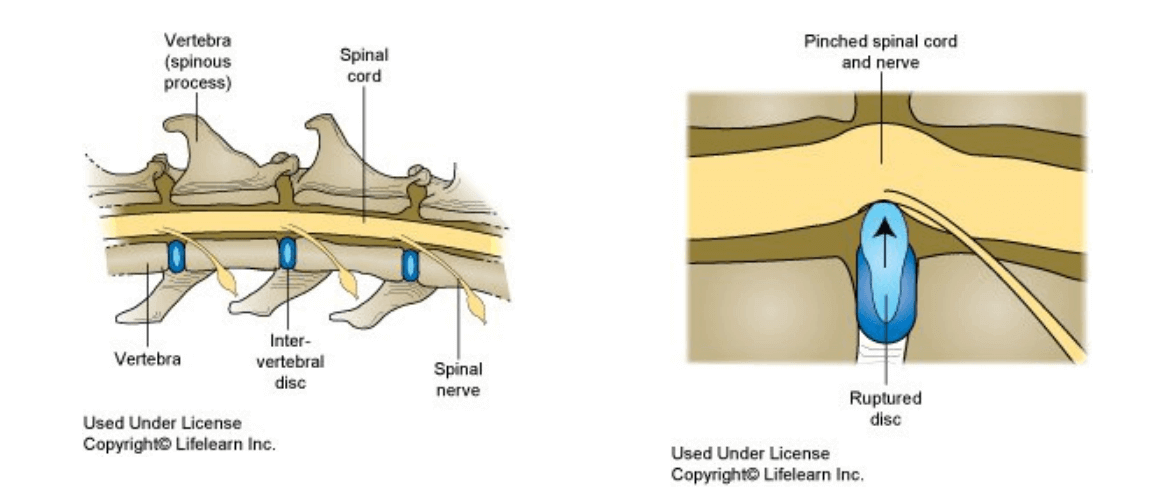What is Intervertebral Disc Disease?
IVDD is a relatively common degenerative condition affecting all types of dogs, although small breeds and long-backed breeds (such as Dachsunds, Corgis, and Poodles) are more commonly affected. German Shepherds and Dobermans are also predisposed to IVDD. This condition is commonly referred to as a “slipped disc”.
The intervertebral discs function as a cushion between the vertebrae of the spine. The spinal cord, the main pathway for nerve signals from the brain to the rest of the body, runs through a bony canal created by the spinal cord. IVDD causes degeneration of the outer fibrous layer of the disc, allowing the softer inner cushion to escape. When an intervertebral disc ruptures or bulges, it can press on the spinal cord, causing pain and blocking the flow of nerve signals. The inflammation and swelling of the surrounding area caused by the bulging disc can worsen symptoms.

There are two types of IVDD:
- Type 1 - Acute/sudden rupture of the disc, often associated with significant pain and/or neurologic deficits. Although symptoms may have a sudden onset and can be associated with trauma (such as falling), degeneration of the disc has likely been occurring for some time before rupture occurred.
- Type 2 - Chronic degeneration and bulging of the disc, more commonly associated with waxing/waning symptoms and progressive neurologic deficits which may be mild and difficult to identify.
What are the symptoms Intervertebral Disc Disease?
Symptoms of IVDD can range from mild general discomfort and restlessness to complete paralysis. The severity and parts of the body affected depend on where in the back the disc is bulging and how much the spinal cord is compressed. More compression of the spine leads to fewer nerve signals getting through, and more neurologic deficits are seen. Mild compression may lead to ataxia or paresis (walking as though drunk, scuffing toes, not knowing where the feet are in space), where more severe compression can lead to complete paralysis (inability to use the affected legs).
-
Hunched back or stiff neck with or without pain when touched on neck or back
-
Loose, swaying back leg gait, as if uncoordinated. When severe, the pet may appear paralyzed in the back legs such that the legs fall under the pet or drag when he/she tries to walk.
-
Reluctance to jump or to ascend/descend stairs
-
Inappropriate or incontinent urination and/or feces
-
More vocal than usual, especially when posturing to sit, lie, down, walk, or climb
-
Withdrawn or subdued manner, might hide or stay in one place.
How is IVDD diagnosed?
Your veterinarian will begin with a thorough history (since sometimes pain and symptoms are decreased by stress hormones released during vet visits). They will also perform a thorough physical exam, including a neurologic exam. They will be looking for specific areas of back pain, presence of normal unconscious reflexes, and the presence of conscious proprioception (knowing where the feet are in space). The combination of findings will help your veterinarian localize the lesion.
While suspicion of IVDD can be made based on physical exam, diagnostic imaging is required for a true diagnosis. Your veterinarian will likely first recommend x-rays of the spine. Although an x-ray can’t show the discs themselves, it can show narrowed spaces between the vertebrae (suggesting lack of normal disc in that space), calcification of disc material consistent with degeneration, and the presence of spondylosis (see below). If more advanced imaging is required, a CT Myelogram or MRI may be recommended, which can allow actual visualization of the discs.
What is spondylosis in Dogs?
As your dog moves, his or her spine moves, too. Over time, the spine can develop areas of wear that can lead to instability between vertebrae. The body attempts to stabilize the areas of wear by depositing extra bone between the vertebrae, thus creating a bony bridge---a condition known as spondylosis. Usually when this occurs over time, pets do not experience pain or other signs at the area of bony bridging. That is, you and your pet are likely unaware that the condition is happening. However, on radiographs (x-ray images) spondylosis can be seen, often as an incidental finding when a pet is x-rayed for another reason. The bridging is seen in an arc pattern of adjacent vertebrae and can sometimes span several vertebrae in succession. Sites of spondylosis typically occur at vertebrae that differ in shape such as the junction of the neck (cervical region) to the chest (thoracic region) or chest to the lower spine and hips (lumbar and/or sacral region). In rare cases, spondylosis can be so thickened and widespread that a pet’s flexibility is reduced and nearby nerve roots are compressed. In such cases, your veterinarian will advise you whether medical and/or surgical intervention are warranted, and whether weight loss and a combination of physical therapy may help.
How is IVDD treated?
Treatment options for IVDD are based on the stage or severity of the disease.
- Stage 1 produces mild pain and is usually self-correcting in a few days.
- Stage 2 causes moderate to severe pain in the neck or lumbar (lower back) area.
- Stage 3 causes partial paralysis (paresis) and results in the dog walking in staggering or uncoordinated movements.
- Stage 4 causes paralysis but the ability to feel (deep pain) is present.
- Stage 5 causes paralysis and loss of feeling.
Most cases are Stage 1, 2, or 3. Your veterinarian will likely recommend anti-inflammatory therapy (with either NSAIDs or steroids depending on the severity and individual patient needs), pain medication, and very strict rest. Most lower stage cases can return to normal or mostly normal function with appropriate medical therapy.
Strict rest for at least 2-3 weeks is a crucial part of medical therapy because any excessive movement can cause further bulging of the disc and worsening of symptoms. Given time the bulging disc material should harden and stabilize, alleviating or reducing the compression on the spinal cord. For most pets, strict rest means being crated when not supervised, or at least confined to a small area where there is no furniture. Pets should ABSOLUTELY NOT be allowed to jump on and off of furniture, and stairs should be avoided as much as possible. Pets should have short (5 minutes or less) leash walks for elimination purposes only, and if the bulging disc is in the neck a harness should be worn to avoid any compression of the neck by a traditional collar.
Your veterinarian may also recommend alternative or adjunctive therapies to improve results with medical management. Use of alternative therapies has been shown in many studies to return normal function and reduce pain faster than medication alone. These alternative therapies include laser and acupuncture, which both reduce inflammation and pain via pathways not available to traditional medication. Electroacupuncture also helps to stimulate the spine and nerves with mild electricity, reducing the impact of IVDD on peripheral nerves and stimulating normal nerve function.
If your pet has Stage 4 or 5 IVDD with significant neurologic deficits (ie paralysis or inability to walk), your veterinarian may suggest a surgical procedure to remove the bulging disc material and relieve the pressure on the spinal cord. The success rate of surgery is much higher when the surgery takes place within 24 hours of the onset of symptoms, and recovery takes several days to weeks. If surgery is recommended your veterinarian will refer you to a specialist (neurologist or surgeon) for this procedure.
What is the prognosis? Will this happen again?
Most cases of low-grade IVDD respond very well to medical management, although in some cases neurologic deficits (such as scuffing toes or tripping easily) may persist. Mild neurologic deficits typically do not have a significant impact on the pet’s quality of life. Your veterinarian can help suggest lifestyle changes to help them cope, such as toe grips and specific exercise. “Flare-ups” of back pain may occur, especially with trauma or over-exertion, and will be managed with similar medications and rest as needed. It is also possible that additional discs at different locations may become affected. Your veterinarian will likely recommend long term joint health supplements, such as Dasuquin Advanced, to keep discs healthy.
Why isn’t my pet getting better?
In some cases, pets fail to respond to medical management. This may be because the compression of the spine is too significant or because multiple sites are affected. It is also possible that other diseases which affect the nervous system are involved. Some of these include Fibrocartilagenous Embolism (FCE - a clot blocking blood supply to a section of spinal cord) or degenerative diseases of the peripheral nerves. More specific tests and advanced imaging, such as an MRI, are typically required to diagnose these diseases.
For a downloadable PDF version of our IVDD handout, click here.
